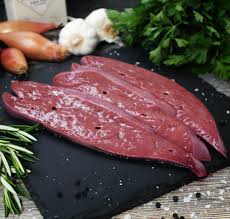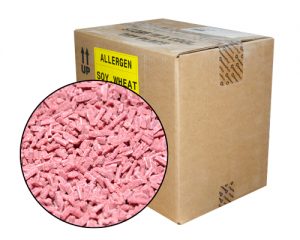A matched case–control study in Quebec, Canada, evaluated consumption of veal liver as a risk factor for campylobacteriosis. Campylobacter was identified in 28 of 97 veal livers collected concurrently from slaughterhouses and retailers. Veal liver was associated with human Campylobacter infection, particularly when consumed undercooked.
 Recent investigations conducted in Quebec, Canada, after an increased number of sporadic campylobacteriosis illnesses suggested that consumption of veal liver may be a risk factor for campylobacteriosis. Many of the persons infected reported eating veal liver, and many of those had eaten it pink or undercooked. The association between campylobacteriosis and the consumption of meat products, including chicken liver and offal from different animal species, has been previously described (1–5). We designed an epidemiologic study to examine the relationship between veal liver consumption and campylobacteriosis.
Recent investigations conducted in Quebec, Canada, after an increased number of sporadic campylobacteriosis illnesses suggested that consumption of veal liver may be a risk factor for campylobacteriosis. Many of the persons infected reported eating veal liver, and many of those had eaten it pink or undercooked. The association between campylobacteriosis and the consumption of meat products, including chicken liver and offal from different animal species, has been previously described (1–5). We designed an epidemiologic study to examine the relationship between veal liver consumption and campylobacteriosis.
We conducted a matched case–control study to examine a potential association between veal liver consumption and campylobacteriosis, using salmonellosis cases as controls. The study began in September 2016 and continued for 9 months. Salmonellosis and campylobacteriosis cases are reportable in Quebec; we selected all subjects from the provincial reportable disease registry. We used a systematic sampling method to select every fifth reported campylobacteriosis case-patient >45 years of age. We paired each campylobacteriosis case-patient with 1 salmonellosis case-patient by age group (45–64 and >65 y) and sex; both infections were confirmed by fecal culture. We matched case-patients if the salmonellosis sample was collected within a window of 7 days before to 60 days after the campylobacteriosis sample was collected. Inclusion criteria for cases and controls were infection that was sporadic and domestically acquired. Exclusion criteria were co-infection with another pathogen, being part of a recognized outbreak, or contact with a gastroenteritis case-patient <10 days before illness.
We administered a structured questionnaire by telephone to collect information on exposures in the 7 days before illness onset. Exposures were consumption of meat and unpasteurized milk products, contact with animals, drinking and recreational water exposures, and occupational exposures. In particular, we investigated consumption of a variety of livers and the degree to which they were cooked. We conducted matched univariate and multivariate analysis to estimate odds ratios (OR) for each exposure.
In addition, we collected samples of veal, chicken, pork, and beef livers from slaughterhouses and retail stores in Quebec between October 2014 and March 2017. We tested each liver specimen for the presence of Campylobacter, Salmonella, and Escherichia coli O157:H7 by using standardized methods (6,7).
We matched a total of 112 campylobacteriosis cases to salmonellosis cases. We found no significant statistical difference in the age or sex distribution of retained cases or controls and the excluded patients. The species of Campylobacter were C. jejuni (79.5%), C. jejuni/coli undifferentiated (3.6%), C. coli (0.9%), other (1.8%), and not identified (14.3%). Among campylobacteriosis case-patients, 42 (37.5%) consumed veal liver and 29 (69.0%) ate it undercooked.
Only the consumption of veal liver and having contact with farm animals were statistically significantly associated with campylobacteriosis (Table 1). After applying the Bonferroni correction to adjust for multiple comparisons (0.05 level of significance divided by 45 variables tested yields α = 0.001), only veal liver consumption remained as a statistically significant exposure (matched OR 9.50, 95% CI 3.39–26.62; p = 0.000001).
Among veal liver consumers, adequate cooking (e.g., well-cooked vs. pink or rare, on the basis of the participant’s subjective observation) was protective. Specifically, 13 (30.2%) of 43 case-patients versus 6 (85.7%) of 7 controls ate their veal liver well-cooked (unmatched OR 0.07, 95% CI 0.002–0.72; p = 0.02). Multivariate analysis using logistic regression confirmed that a statistically significant association between the consumption of veal liver and campylobacteriosis remained when all other exposures were included as covariates. Although we conducted this study among persons ≥45 years of age, it is reasonable to assume that eating veal liver, especially undercooked, would also carry risk for younger persons.
We sampled 339 veal, pork, chicken, and beef livers collected from 138 retailers and 16 slaughterhouses. When we evaluated all livers collected at both locations, we detected Campylobacter in 28.0% of veal livers, 22.2% of pork livers, 36.8% of chicken livers, and 19.1% of beef livers (Table 2). We detected Salmonella more frequently in chicken livers (22.1%) and pork livers (19.1%) than in veal livers (3.1%); we did not detect Salmonella in beef livers. We rarely identified E. coli O157:H7 in livers of any kind. The proportion of contaminated livers differed between animal species and also with respect to location of sampling. A higher proportion of veal livers (35.7%) collected from retailers were contaminated by Campylobacter, compared with veal livers collected from slaughterhouses (16.2%). We observed the reverse for chicken and pork livers. The reason for these variations is unclear at this time, but this finding may be an artifact resulting from the relatively small number of samples taken at each location.
Cattle are a well-known reservoir for a variety of Campylobacter species, such as C. jejuni, C. coli, and C. fetus (8,9). Campylobacter species have been isolated from beef intestinal contents and also from beef bile, bile ducts, gallbladder, and liver (10–14). The gallbladder and bile contain substances that have a chemoattractant effect on C. jejuni, which explains the presence of Campylobacter within the biliary tract (10,15). Liver contamination varies between animal species (10–14). Chicken liver, for example, can be contaminated by Campylobacter and Salmonella and has been the source of several outbreaks (3,4,11,13). Because few case-patients consumed livers from other animal species during our study, we were not able to identify any substantial risks associated with those exposures.
Because livers may be collected from several animals and stored together, they may be contaminated during the evisceration process or by cross-contamination (11). Both the external and internal tissue of a liver may be contaminated with Campylobacter, and inadequate cooking may not fully inactivate Campylobacter and Salmonella (10,11), which is a cause for concern because ≈70% of the patients with campylobacteriosis who consumed veal liver in our study reported eating it undercooked. We did not examine possible cross-contamination of foods and surfaces and the host-related factors that may increase the risk for enteric diseases.
Conclusions
Our study identified a strong and statistically significant association between the consumption of veal liver and sporadic, domestically acquired campylobacteriosis among persons >45 years of age in Quebec. We found that adequate cooking of veal liver mitigates the risk of infection. We detected Campylobacter in almost one third of veal livers we sampled from slaughterhouses and retail stores, which supports our finding that veal liver consumption is a risk factor for campylobacteriosis. In light of these results, we recommend the dissemination of safe food handling practices for veal liver and other offal for retailers, food establishments, slaughterhouses, and the general public.
Dr. Gaulin is a physician epidemiologist who works in public health at the Protection Branch of the Ministry of Health in Quebec, Canada. She works in infectious diseases on enteric and nonenteric disease surveillance and also coordinates provincial outbreak investigations.
Veal Liver as Food Vehicle for Human Campylobacter Infections
Gaulin C, Ramsay D, Réjean Dion R, Simard M, Gariépy C, Levac É, et al. Veal liver as food vehicle for human Campylobacter infections. Emerg Infect Dis. 2018 Jun [date cited]. https://doi.org/10.3201/eid2406.171900
DOI: 10.3201/eid2406.171900
https://wwwnc.cdc.gov/eid/article/24/6/17-1900_article#suggestedcitation
 Earlier in March, food safety officials warned the public about a possible health risk in consuming a smoked trout spread sold at several establishments throughout Quebec because it is likely to contain Listeria monocytogenes.
Earlier in March, food safety officials warned the public about a possible health risk in consuming a smoked trout spread sold at several establishments throughout Quebec because it is likely to contain Listeria monocytogenes.














